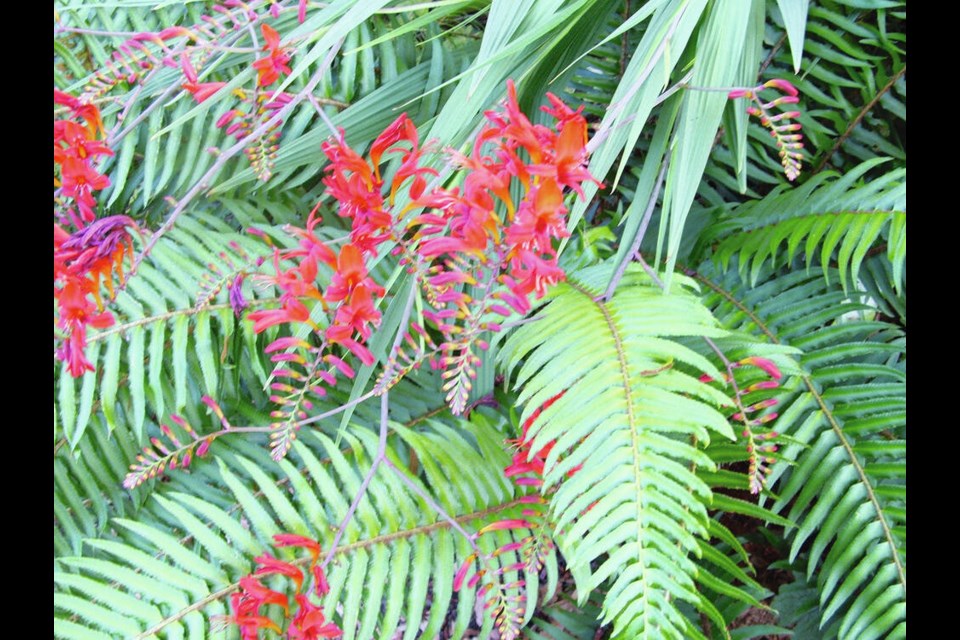Dear Helen: Have you ever grown Crocosmia? I am looking for attractive perennials that will not require much maintenance or become aggressively invasive while forming showy clumps of foliage and flowers. This plant has been among those recommended by friends. Your opinion?
E.G.
I do have a very old clump of Crocosmia. I think it is the one called Lucifer. It is planted across a path from my little greenhouse, next to one of the many native sword ferns on the property. It’s been there for several decades, re-growing in the spring and flowering in summer with practically no attention except for clearing away dead and fallen growth in late winter or early spring.
My hefty clump of Crocosmia has not spread aggressively at all, perhaps because the plants are located at a dryish edge of the garden, in soil that is not regularly replenished. In cushier conditions, especially if post-bloom seeds drop and germinate or/and the corms the plants grow from produce prolific numbers of baby corms, spreading could become an issue.
There are many varieties of Crocosmia. Some are problem spreaders. Varieties are easily researched online for their tendency to become invasive.
By early June this year, the plants had produced a showy patch of beautiful sword-shaped leaves, brilliant green and extra perky this year because of the May rains and coolish temperatures. Soon, gracefully arched flower stems will appear, some of them drooping down enough to decorate the sword fern foliage below.
Crocosmia corms are available in early spring at some garden centres. Brother Nature Seeds in Victoria lists seeds for Lucifer.
Dear Helen: Is there a way to keep my border sedums (the taller types) from flopping over with the weight of the flower heads in late summer?
L.F.
Cutting the stems back will help to produce more compact, sturdy plants. Ideal timing for a severe cutting back, by about a half, is late May to early June, Now, I’d trim the stems back less drastically, by around a third.
Dear Helen: My first-time garlic planting is looking good and I’m wondering about its care at this point in the season. Is it true that garlic requires no spring or early summer watering?
J.A.
In previous annual weather patterns, it was mostly true that garlic plantings usually did not need watering during these times. Weather patterns, however, have changed dramatically in recent years.
Last year’s extremely hot May weather, especially following a far drier than usual winter and early spring, called for watering of garlic — unless the plants were growing in highly humus-rich, moisture-retentive soil that was heavily mulched.
This year is very different. Rainfall has been fairly regular, up until early June. Garlic plantings will need watering only if the weather turns very hot and the soil is sandy and fast draining.
Be sure to cut off the curly flower stems that emerge on the plants this month. Removing them diverts the plants’ energies into bulb formation. The curly stems (“scapes”) are delicious chopped finely into salads or added to stir-fries, stews and other cooked dishes.
Garlic is harvested in July, when half of the top growth has turned brown. To be sure the bulbs are well cured, stop watering in the fourth week of June.
GARDEN EVENTS
Floral arts. The Mid Island Floral Art Club will meet on Thursday, June 13, at 2 p.m. in St. Stephen’s Church hall, 150 Village Way in Qualicum Beach. Irene will be demonstrating “Living Moss Wreaths and Garden Decor.” She will describe how to decorate with all natural materials and how to plant and care for succulents. New members welcome. Guest fee $6. Information at [email protected].
Denman tour. The Denman Island Home and Garden Tour, a biennial event supporting the Denman Conservancy Association, will take place on Saturday and Sunday, June 15 and 16, 9 a.m. to 4 p.m. Among the 12 venues on the tour are the home and botanical haven of Sandy and Des Kennedy and Bee Balm’s home “Mossy Hollow.” Each home and garden tells a story of conservation and creativity, from beachfront cottages to lush hobby farms. Further details at , where tickets at $25 can be purchased online. Other ticket sources: Garden Works (Courtenay), Denman Hardware (Denman Island), Hornby Gas Bar (Hornby Island), Ken Dor (Qualicum), Cultivate (Parksville), Weinberg’s (Buckley Bay), Blue Heron Books (Comox).



